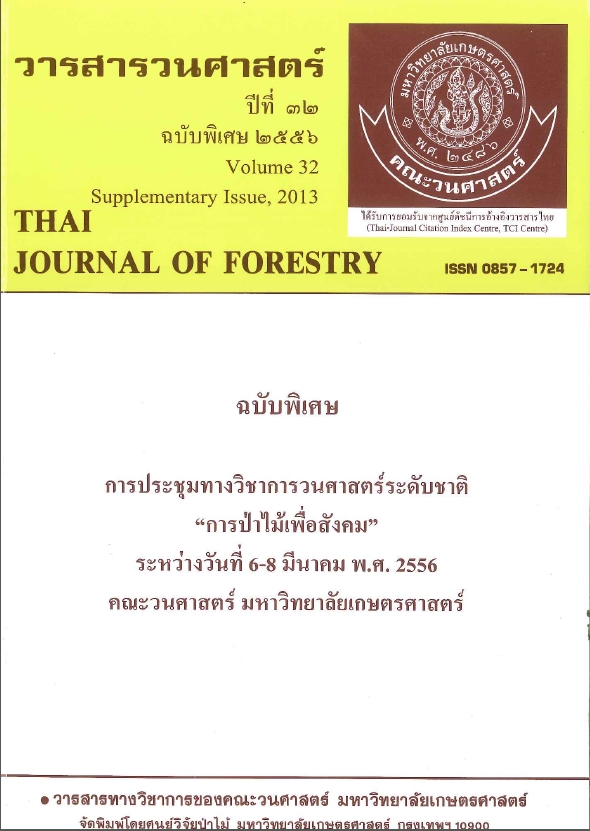Land Use on the Newly Formed Mudflat for Blood Clam Culture at Khlong Khon Sub-district, Mueang District, Samut Songkhram Province
Main Article Content
Abstract
This study was aimed to conduct a land use survey on the newly formed mudflat. Three villages were selected for this study including Ban Prak Talay, Ban Khlong Chong and Ban Khlong Chong Noi. Problems related to land use on the newly formed were identified and the mitigation measures were recommended. Rapid Rural Appraisal (RRA) technique and structured interview of all blood clam farmers were used. Leveling of the mudflat was conducted using a portable sonar meter. The collected data were analyzed by statistical program and calculated data were consisted of minimum value, maximum value, frequency of respond, percentage of respond, mean, and chi-square with statistical significance set at 0.05.
Results showed that, land use on the newly formed mudflat in the study area was divided into the area for blood clam farming (2,505.22 rai, 89.03 percent) and other area (308.57 rai, 10.97 percent). From the overall of 102 repondents, all have the permits from the Department of Fisheries (with the average of 19.28 rai/person). The permits were charged at 80 baht/rai/year. Range of water in the cultured area is 1.9 meters during high tide. Blood clam farmers have the average age of 50 years with the roughly equal member and 85.30 percent of the informants were educated from elementary school. Blood clam farming is the main occupation and mostly cultured traditionally by workers who were family members. More than half of farmer bought blood clam seeds imported from Malaysia and about one-third from Surat Thani. Culturing periods varied depending on the elevation of the mudflat (depth of water) that ranged from 7 to 18 months and higher the mudflat take longer cultured period. Average yield was about 7.5 tons/rai, and the costs and benefits from the culture were approximately 32,732.84 and 60,450.25 baht/rai/year, net profit being 27,717.41 baht/rai/year. Some obstacles reducing the ability to use the newly formed mudflat were changes in water quality, planted mangroves on the newly formed mudflat, natural predators of blood clam and blood clam theft. Factors affecting net income were the relatively high mudflat, space of formed mudflat, size, amount and density of the blood clams species (p=0.05).
Keywords: land use, newly formed mudflat, blood clam farmer, Khlong Khon sub-district
Downloads
Article Details

This work is licensed under a Creative Commons Attribution-NonCommercial-NoDerivatives 4.0 International License.
ข้าพเจ้าและผู้เขียนร่วม (ถ้ามี) ขอรับรองว่า ต้นฉบับที่เสนอมานี้ยังไม่เคยได้รับการตีพิมพ์และไม่ได้อยู่ในระหว่างกระบวนการพิจารณาตีพิมพ์ลงในวารสารหรือสิ่งตีพิมพ์อื่นใด ข้าพเจ้าและผู้เขียนร่วม (ถ้ามี) ยอมรับหลักเกณฑ์และเงื่อนไขการพิจารณาต้นฉบับ ทั้งยินยอมให้กองบรรณาธิการมีสิทธิ์พิจารณาและตรวจแก้ต้นฉบับได้ตามที่เห็นสมควร พร้อมนี้ขอมอบลิขสิทธิ์ผลงานที่ได้รับการตีพิมพ์ให้แก่วารสารวนศาสตร์ คณะวนศาสตร์ มหาวิทยาลัยเกษตรศาสตร์ กรณีมีการฟ้องร้องเรื่องการละเมิดลิขสิทธิ์เกี่ยวกับภาพ กราฟ ข้อความส่วนใดส่วนหนึ่ง หรือ ข้อคิดเห็นที่ปรากฏในผลงาน ให้เป็นความรับผิดชอบของข้าพเจ้าและผู้เขียนร่วม (ถ้ามี) แต่เพียงฝ่ายเดียว และหากข้าพเจ้าและผู้เขียนร่วม (ถ้ามี) ประสงค์ถอนบทความในระหว่างกระบวนการพิจารณาของทางวารสาร ข้าพเจ้าและผู้เขียนร่วม (ถ้ามี) ยินดีรับผิดชอบค่าใช้จ่ายทั้งหมดที่เกิดขึ้นในกระบวนการพิจารณาบทความนั้น”


